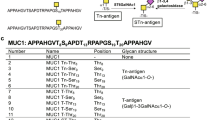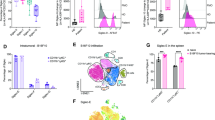Abstract
A number of adenocarcinomas abundantly express and secrete underglycosylated MUC1 mucin. Underglycosylation exposes tandem repeat peptide sequences on cancer-associated MUC1 mucin that are normally cryptic. High levels of MUC1 mucin are correlated with a poor prognosis and immunosuppression in adenocarcinoma patients. In this report we show that cancer-associated MUC1 mucin, affinity-purified from ascites fluids of cancer patients, and synthetic tandem repeats of MUC1 mucin core peptide can suppress human T-cell proliferative responses. This MUC1 mucin-induced suppression of T-cell responses can be reversed by the addition of exogenous IL-2 or anti-CD28 monoclonal antibody. These results are consistent with other studies showing that lymphocytes present in the vicinity of tumor cells are anergic and can be reactivated with exogenous interleukin-2. Overcoming MUC1 mucin-induced immunosuppression with IL-2 combined with active specific immunotherapy might be an effective immunotherapeutic strategy against human adenocarcinomas.
This is a preview of subscription content, access via your institution
Access options
Subscribe to this journal
Receive 12 print issues and online access
$209.00 per year
only $17.42 per issue
Buy this article
- Purchase on Springer Link
- Instant access to full article PDF
Prices may be subject to local taxes which are calculated during checkout
Similar content being viewed by others
References
Hanisch, H.-G. et al. Structure of O-linked polyacrosaminoglycans on human skim milk mucin: A novel type of linearly extended poly-N-acetyl-lactosamine backbones with Gal β (1-4) GlcNAcb (1-6) repeating units. J. Biol. Chem. 264, 872–883 (1989).
Gendler, S., Taylor-Papadimitriou, J., Duhig, T., Rothbard, J. & Burchell, J.A. A highly immunogenic region of a human polymorphic epithelial mucin expressed by carcinomas is made up of tandem repeats. J. Biol. Chem. 263, 12820 (1988).
Siddiqui, J. et al. Isolation and sequencing of a cDNA coding for the human DF3 breast carcinoma-associated antigen. Proc. Natl. Acad. Sci. USA 85, 2320 (1988).
Parry, G., Beck, J.C., Moss, L., Bartley, J. & Ojakian, G.K. Determination of apical membrane polarity in mammary epithelial cell cultures: The role of cell-cell, cell-substratum, and membrane-cytoskeleton interactions. Exp. Cell Res. 188, 302–311 (1990).
Zotter, S., Hageman, P.C., Lossnitzer, A., Mooi, W.J. & Hilgers, J. Tissue and tumor distribution of human polymorphic epithelial mucin. Cancer Rev. 11, 55–101 (1988).
Burchell, J. et al. Development and characterization of breast cancer reactive monoclonal antibodies directed to the core protein of the human milk mucin. Cancer Res. 47, 5476–5482 (1987).
Bresalier, R.S. et al. Mucin production by human colonic carcinoma cells correlates with their metastatic potential in animal models of colon cancer metastasis. J. Clin. Invest. 87, 1037–1045 (1991).
Kobayashi, H., Terao, T. & Kawashima, Y. Serum sialyl Tn as an independent predictor of poor prognosis in patients with epithelial ovarian cancer. J. Clin. Oncol. 10, 95–101 (1992).
Nakamori, S., Ota, D.M., Cleary, K.R., Shirotani, K. & Irimura, T. MUC-1 mucin expression as a marker of progression and metastasis of human colorectal carcinoma. Castroenterology 106, 353–361 (1994).
Berruti, A. et al. Prognostic value in predicting overall survival of two mucinous markers: CA 15-3 and CA 125 in breast cancer patients at first relapse of disease. Eur. J. Cancer. 30A, 2082–2084 (1994).
McGuckin, M.A., Walsh, M.D., Hohn, B.G., Ward, B.G. & Wright, R.G. Prognostic significance of MUC-1 epithelial mucin expression in breast cancer. Hum. Pathol. 26, 432–439 (1995).
Hilkens, J. et al. Is episialin/MUC-1 involved in breast cancer progression? Cancer Lett. 90, 27–33 (1995).
Fung, P.Y.S. & Longenecker, B.M. Specific immunosuppressive activity of epiglycanin, a mucin-like glycoprotein secreted by a murine mammary adenocarcinoma (TA3-HA). Cancer Res. 51, 1170–1176 (1991).
MacLean, G.D., Reddish, M.A. & Longenecker, B.M. Prognostic significance of preimmunotherapy serum CA27. 29 (MUC-1) mucin level following active specific immunotherapy of metastatic adenocarcinoma patients. J. Immunother. 19, 70–78 (1997).
Reddish, M.A., Maclean, G.D., Poppema, S.A., Berg, A. & Longenecker, B.M. Preimmunotherapy serum CA27. 29 (MUC-1) mucin level and CD69+ lymphocytes correlate with effects of theratope sialyl-Tn-KLH cancer vaccine in active specific immunotherapy. Cancer Immunol. Immunother. 42, 303–309 (1996).
Regimbald, L.H. et al. The breast cancer mucin MUC1 as a novel adhesion ligand for endothelial intercellular adhesion molecule 1 in breast cancer. Cancer Res. 56, 4244–4249 (1996).
Gimmi, C.D. et al. Breast cancer-associated antigen, DF3/MUC1, induces apoptosis of activated human T cells. Nature Med. 2, 1367–1370 (1996).
Berd, D. et al. Activation markers on T cells infiltrating melanoma metastases after therapy with dinitrophenyl-conjugated vaccine. Cancer Immunol. Immunother. 39, 141–149 (1994).
Alexander, R.B. et al. Helper T cells infiltrating human renal cell carcinomas have the phenotype of the activated memory-like T lymphocytes. J. Immunother. 17, 39–46 (1995).
Coventry, B.J. et al. Lack of IL-2 cytokine expression despite IL-2 messenger RNA transcription in tumor infiltrating lymphocytes in primary human breast carcinoma. J. Immunol. 156, 3486–3492 (1996).
Kurosaka, A. et al. A monoclonal antibody that recognizes a cluster of a disaccharide, NeuAca2 to 6GalNAc, in mucin-type glycoproteins. J. Biol. Chem. 262, 8724–8726 (1988).
Chan, D.W. et al. Use of Truquant® BR™ RIA for the early detection of breast cancer recurrence in patients with stage II and stage III disease. J. Clin. Oncol. 15, 2322–2328 (1997).
Sad, S. & Mosmann, T.R. Interleukin (IL) 4, in the absence of antigen stimulation, induces an anergy-like state in differentiated CD8+ TC1 cells: Loss of IL-2 synthesis and autonomous proliferation but retention of cytotoxicity and synthesis of other cytokines. J. Exp. Med. 182, 1505–1515 (1995).
Luzzati, A.L. et al. Interferon-gamma (IFN-γ) can counteract the in vitro inhibitory effect of an HIV p24 immunosuppressive heptapeptide. Clin. Exp. Immunol. 105, 403–408 (1996).
Brunner, T. et al. Cell-autonomous Fas (CD95)/Fas-ligand interaction mediates activation-induced apoptosis in T-cell hybridomas. Nature 373, 441–444 (1995).
Barinaga, M. Life-death balance within the cell. Science 274, 724 (1996).
Beverly, B., Kang, S-M., Lenardo, M.J. & Schwartz, R.H. Reversal of in vitro T cell anergy by IL-2 stimulation. Int. Immunol. 4, 661–671 (1992).
Mayumi, H., Umesue, M. & Nomoto, K. Cyclophosphamide-induced immunological tolerance: An overview. Immunobiology 195(2), 129–139 (1996).
Fontenot, J.D. et al. Biophysical characterization of one-, two-, and three- tandem repeats of human mucin (MUC-1) protein core. Cancer Res. 53, 5386–5393 (1993).
Bohmig, G.A., Kovarik, J., Holter, W., Pohanka, E. & Zlabinger, G.J. Specific down-regulation of proliferative T cell alloresponsiveness by interference with CD2/LFA-3 and LFA-1/ICAM-1 in vitro. J. Immunol. 152, 3720–3728 (1994).
Ding, L. et al. Immunogenicity of synthetic peptides related to the core peptide sequence encoded by the human MUC1 mucin gene: Effect of immunization on the growth of murine mammary adenocarcinoma cells transfected with the human MUC1 gene. Cancer Immunol. Immunother. 36, 9–17 (1992).
Apostolopoulos, V., Loveland, B.E., Pietersz, G.A. & McKenzie, I.F.C. CTL in mice immunized with human mucin 1 are MHC-restricted. J. Immunol. 155, 5089–5095 (1995).
Agrawal, B., Reddish, M.A. & Longenecker, B.M. In vitro induction of MUC-1 peptide-specific type 1 T lymphocytes and cytotoxic T lymphocytes responses from healthy multiparous donors. J. Immunol. 157, 2089–2095 (1996).
Berd, D., Mastrangelo, M.J., Engstrom, P.F., Paul, A. & Maguire, H. Augmentation of the human immune response by cyclophosphamide. Cancer Res. 42, 4862–4866 (1982).
Berd, D. & Mastrangelo, M.J. Effect of low dose cyclophosphamide on the immune system of cancer patients: Depletion of CD4+, 2H4+ suppressor-inducer T cells. Cancer Res. 48, 1671–1675 (1988).
Fung, P.Y.S., Madej, M., Koganty, R. & Longenecker, B.M. Active specific immunotherapy of a murine mammary adenocarcinoma using a synthetic tumor-associated glycoconjugate. Cancer Res. 50, 4308–4314 (1990).
Agrawal, B., Reddish, M. & Longenecker, B.M. CD30 expression on human CD8+ T cells isolated from peripheral blood lymphocytes of normal donors. J. Immunol. 157, 3229–3234 (1996).
Reddish, M., Black, N., Almeida, A., Suresh, M.R. & Longenecker, B.M. Epitope mapping of MAb B27.29 within the peptide core of the malignant breast carcinoma-associated mucin antigen coded for the human MUC1 gene. J. Tumor Marker Oncol. 7, 19–27 (1992).
Author information
Authors and Affiliations
Rights and permissions
About this article
Cite this article
Agrawal, B., Krantz, M., Reddish, M. et al. Cancer-associated MUC1 mucin inhibits human T-cell proliferation, which is reversible by IL-2. Nat Med 4, 43–49 (1998). https://doi.org/10.1038/nm0198-043
Received:
Accepted:
Issue Date:
DOI: https://doi.org/10.1038/nm0198-043
This article is cited by
-
Clinical significance of KL-6 in immune-checkpoint inhibitor treatment for non-small cell lung cancer
Cancer Chemotherapy and Pharmacology (2023)
-
A phase I study of an adenoviral vector delivering a MUC1/CD40-ligand fusion protein in patients with advanced adenocarcinoma
Nature Communications (2022)
-
A first-in-human study of the novel metabolism-based anti-cancer agent SM-88 in subjects with advanced metastatic cancer
Investigational New Drugs (2020)
-
New therapeutic targets for cancer: the interplay between immune and metabolic checkpoints and gut microbiota
Clinical and Translational Medicine (2019)
-
Cancer-associated mucins: role in immune modulation and metastasis
Cancer and Metastasis Reviews (2019)



